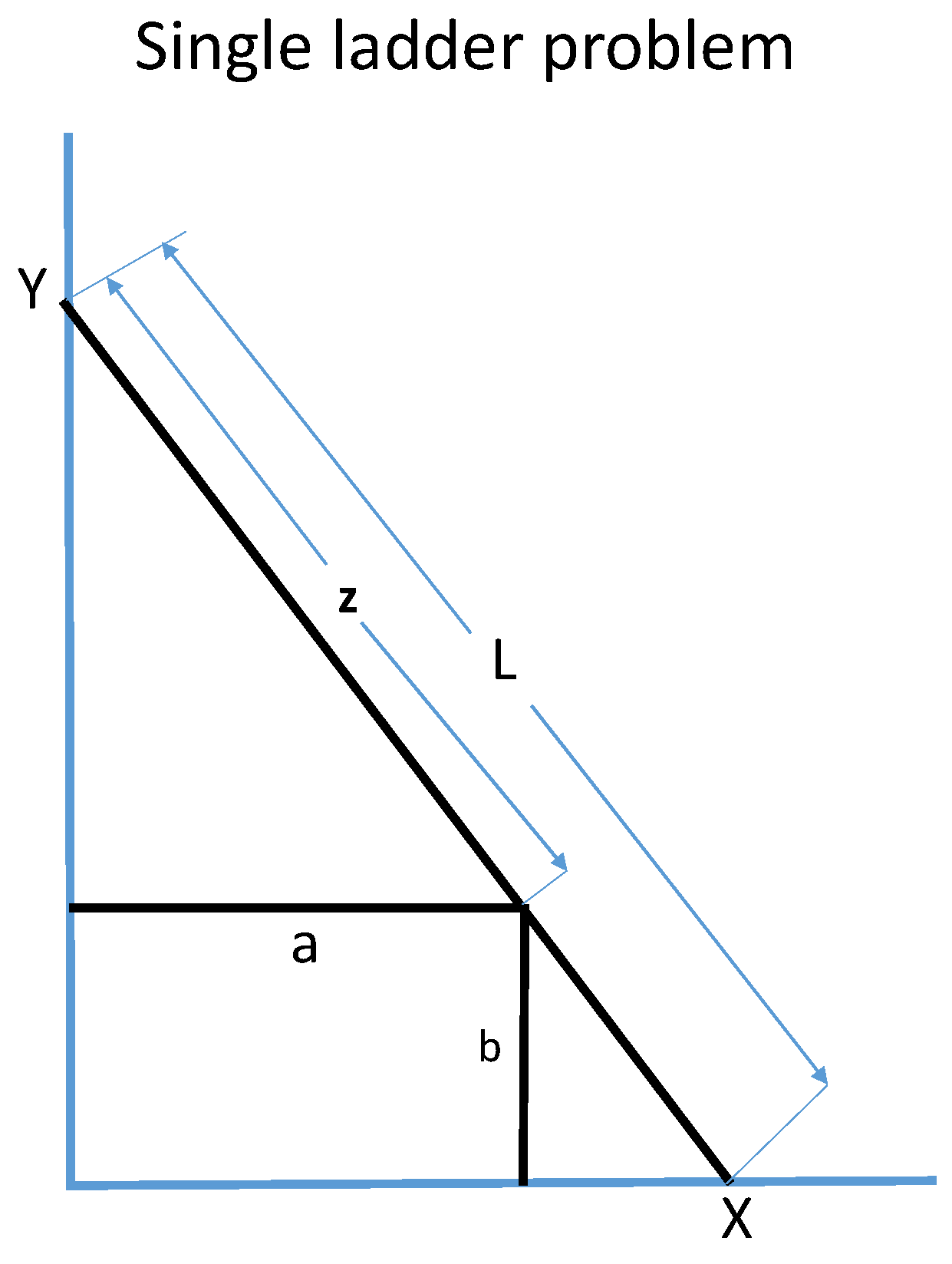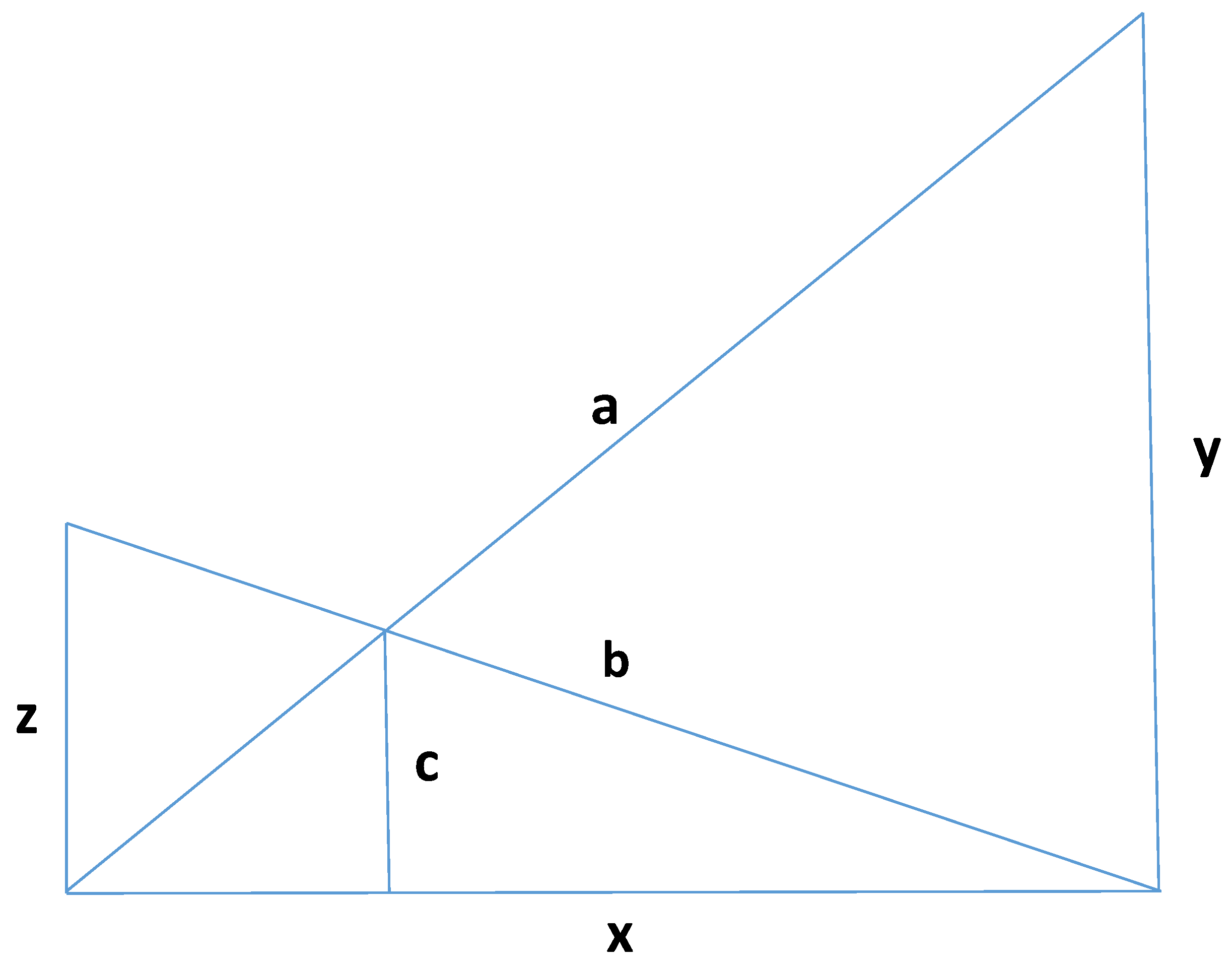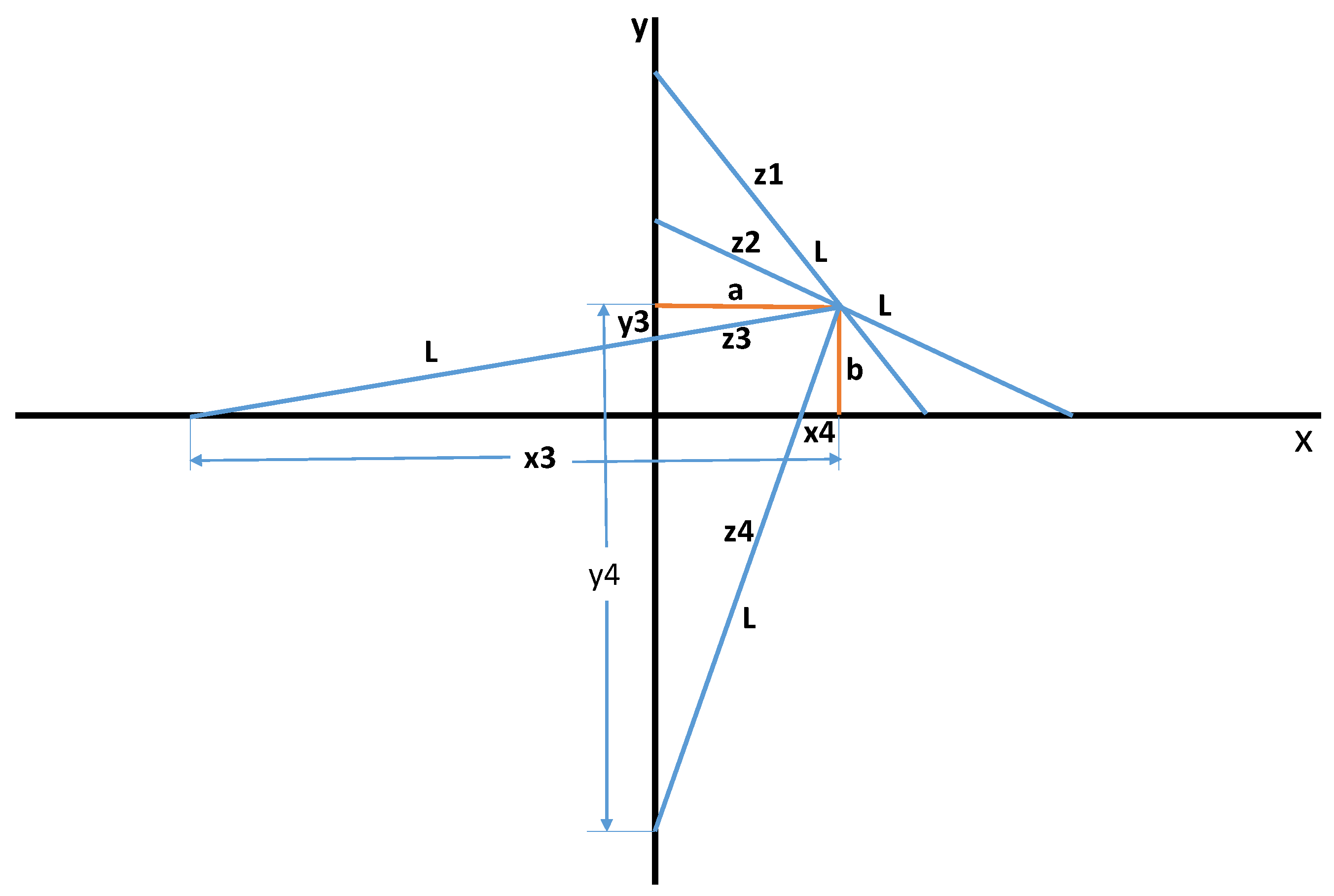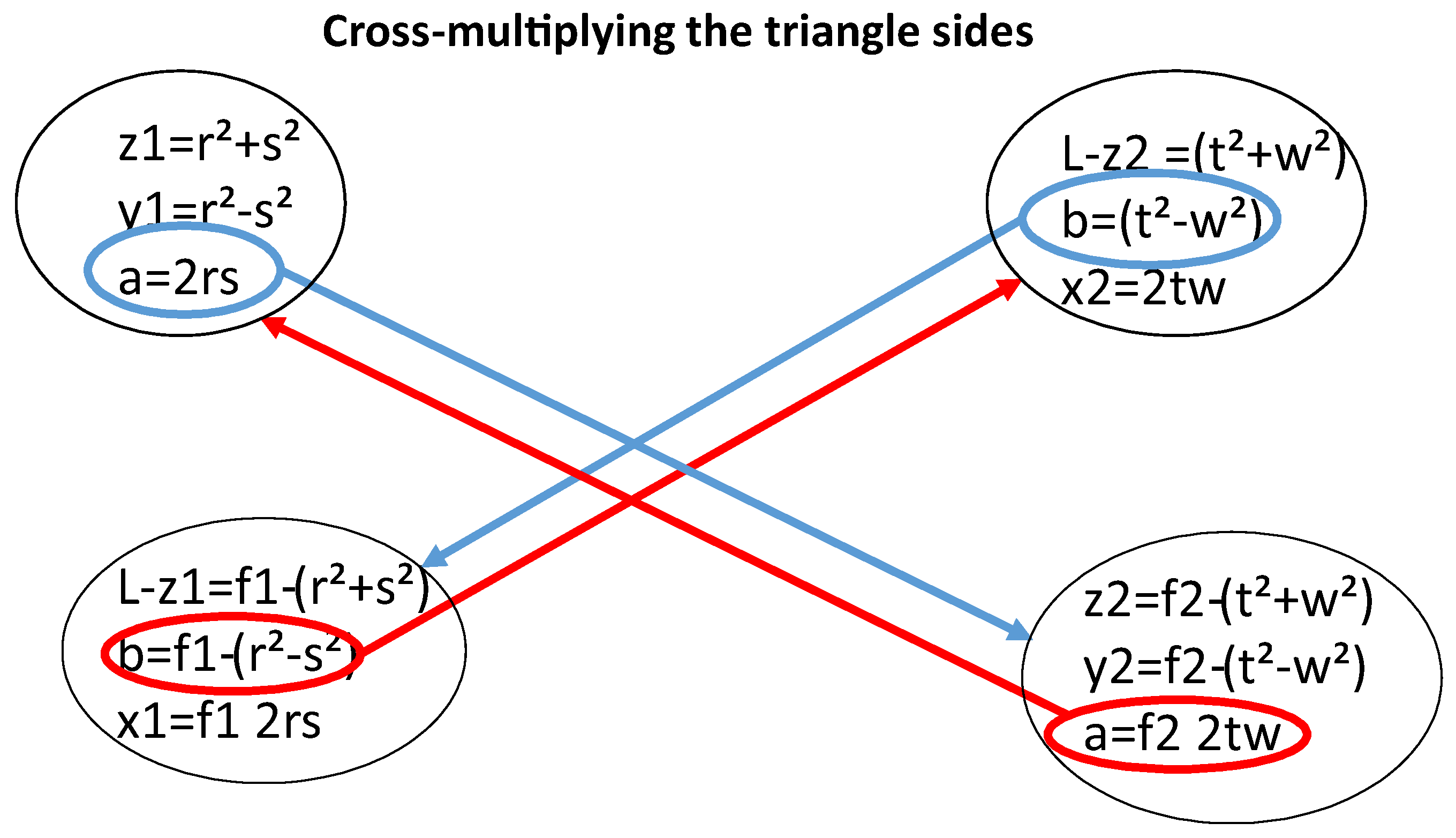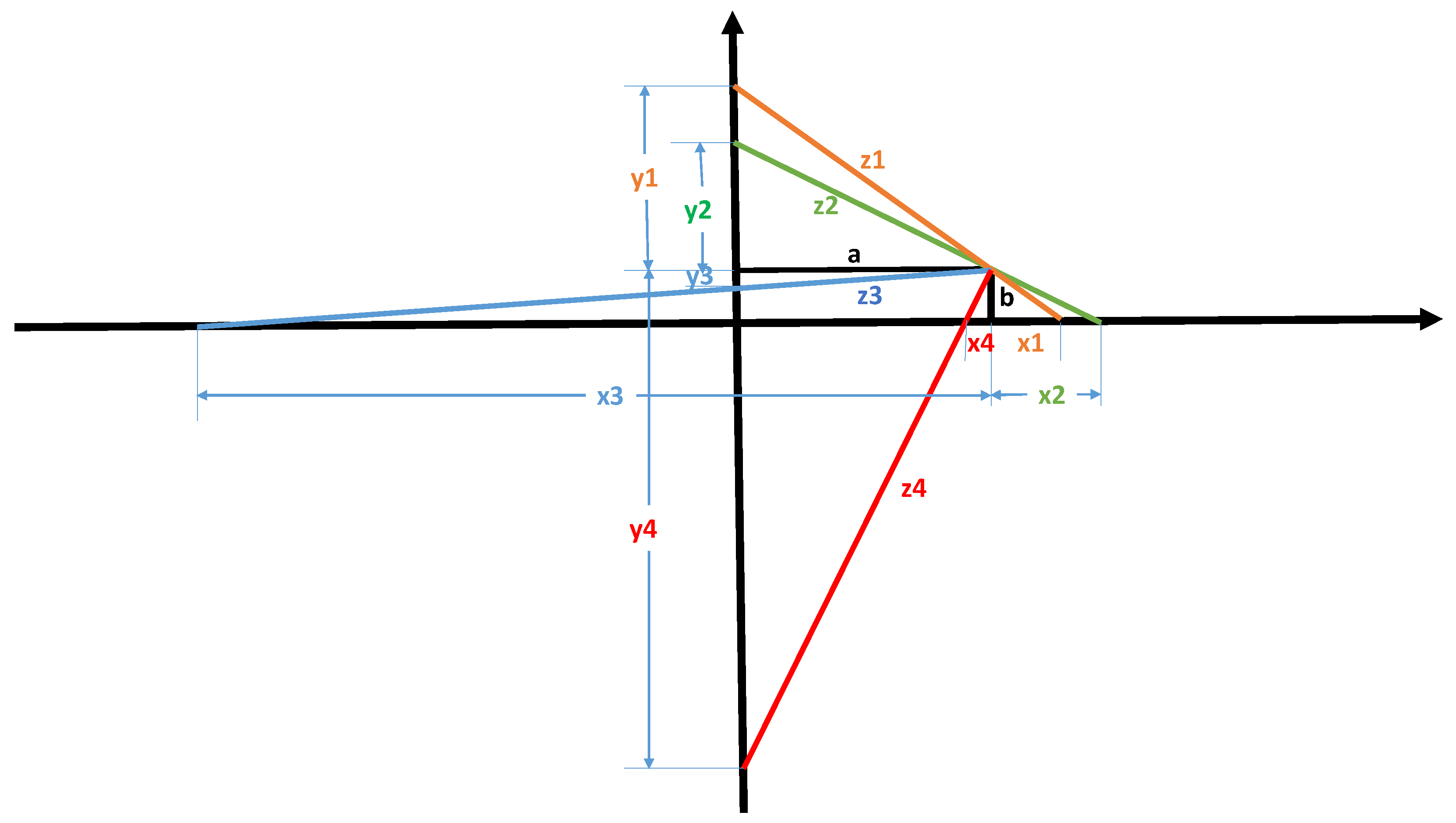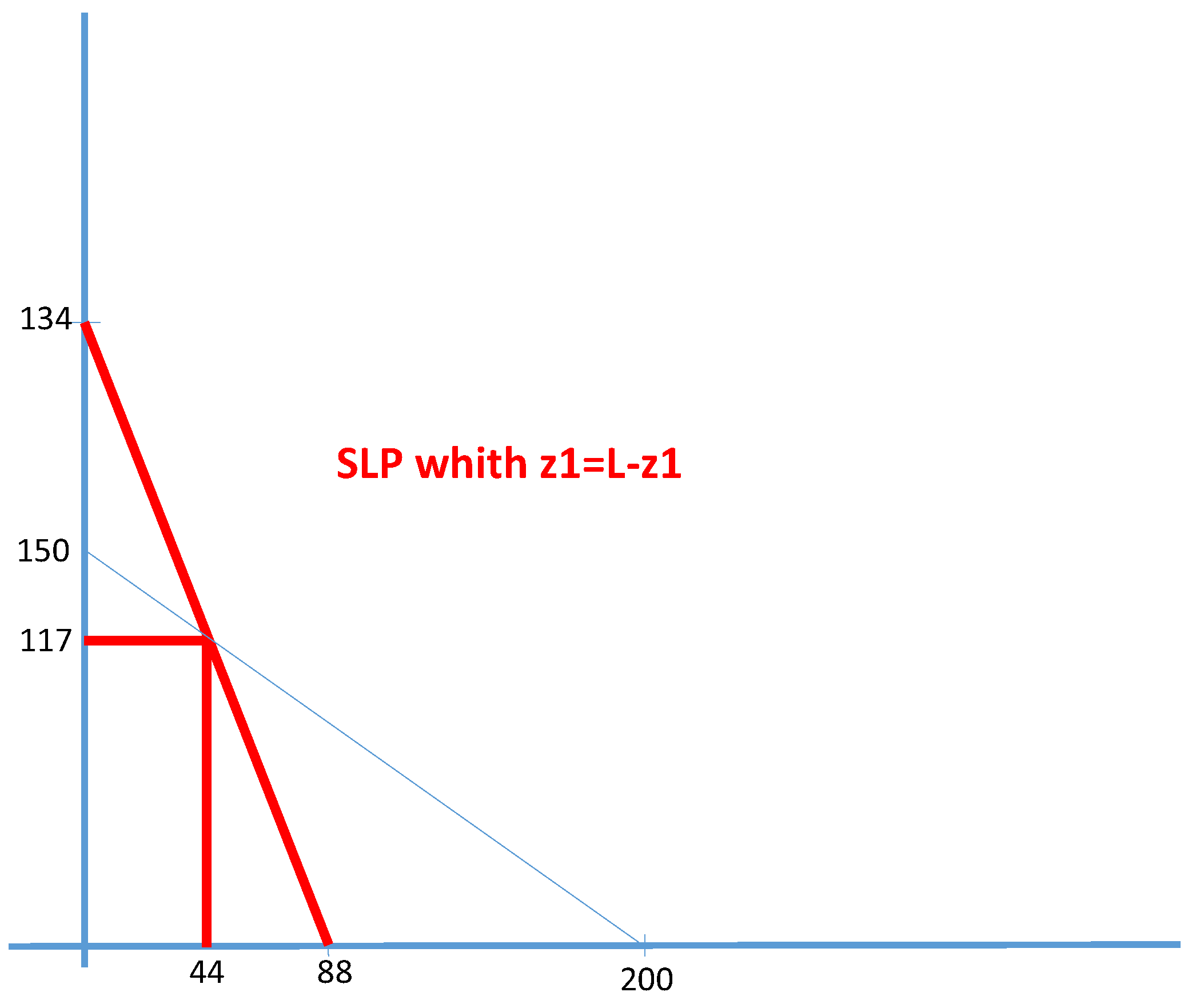1. Introduction
There are a number of algebraic-geometrical problems that have been given names referring to a common geometric feature, the so-called ladder problems. They are separated into two main categories: the single ladder problem (SLP), and where two ladders are involved, the crossed ladder problem (CLP); see
Figure 1 and
Figure 2.
Figure 1 shows a version of SLP also labeled the ladder box problem. Other SLP-varieties are the ladder corner problem, where a ladder is required to be transferred through a corner in a narrow corridor, and the ladder wall problem, where a ladder is raised to a wall and the bottom part of the ladder is sliding along the floor. The authors of this paper have previously studied the properties of CLP in several articles; see, e.g., [
1,
2,
3,
4,
5,
6]. In the current paper the intention has been to research the conditions for finding complete integer parametric solutions to a complex geometrical problem. For this purpose we have found that the ladder box problem of SLP is particularly well suited.
It is well known (see, e.g., [
7] ) that the solutions to the quartic
give solutions to the
single ladder problem (SLP). This problem reads: A ladder of length
L is raised to a wall and touches the corner of a rectangular box with sides
a and
b; see
Figure 1. The problem is to determine how high the ladder reaches on the wall, or, as in this case, the distance of the ladder between the corner of the rectangle and the wall; see, e.g., [
8]. Finding solutions to a nonlinear equation like (1) one would normally require approximate methods, such as Newton’s procedure, or recently developed methods (see, e.g., [
9,
10]), but in this case we are looking for integer solutions and must, in accordance with the legacy of Diophantos, find individually oriented methods. The quartic (
1) follows from eliminating the variable
y from the two simultaneous second degree equations that can be formulated from
Figure 1:
and
If
, then the quartic (
1) can by algebraic manipulations be reduced to solving quadratic equations. If
, then we need to find an algebraic solution to the quartic which requires us to use the traditional and cumbersome methods for solving quartics.
Historically, the problem has attracted great interest from professional mathematicians. The first reference to work on similar problems dates back to classic Greek mathematicians; for example Appolonius (see, e.g., [
11]). In the late renaissance or birth of modern mathematics, Decartes and Newton published several works considering variations over the same basic problem; see, e.g., [
12,
13]. In the eighteenth century, Simpson and Lagrange included work on this problem in textbooks on algebra; see [
14,
15].
Let
denote the minimum length of the ladder in quadrant one for a given set of
a and
. It has been shown that if
, then the problem has four real solutions, two in the first quadrant, one in the third quadrant and one in the fourth quadrant. If
, then the problem has two real solutions in the first quadrant and one real solution in each of the quadrants three and four, and if
, then it has two complex roots in the first quadrant and one real solution in each of the quadrants three and four; see [
7] and cf. also
Figure 3.
Later on, the single ladder problem became a popular subject in both professional and recreational mathematics, and a number of papers have been published; see, e.g., [
7,
16,
17,
18,
19,
20,
21,
22,
23,
24,
25] and also especially the recent review article [
26] by H.S.M. Coxeter and the references given therein.
The authors of this paper claim that by reformulating the problem, other methods are able to be tested and new understanding can be found in the interplay between geometric and algebraic avenues for treating and understanding this problem.
The following idea has especially guided us:
Find complete integer solutions by parametric representation for the quartic in question, both for the two solutions in the first quadrant and for all four solutions.
Use this information to find new information concerning SLP.
The paper is organized as follows: In
Section 1 we prove a new complete integer parametric representation of the two solutions of the quartic in quadrant one. In
Section 2 we present some new methods for deriving integer parametric representation of all four solutions of the quartic.
Section 3 is reserved further contributions to the understanding of and new information concerning the open problem related to
Section 2 (see Remark 15).
2. Complete Parametric Representation for Integer Solutions in the First Quadrant
In [
16] the authors have presented a method to determine (incomplete) integer solutions to the SLP in the first quadrant by parametric representation. In this Section we present another method, which gives complete parametric integer solutions to all the SLP variables in quadrant one.
Theorem 1. A complete integer parametric representation of the two real solutions of the SLP in the first quadrant when can be determined by using four parameters, and , where and : Proof. From similar triangles and using Pythagorean triples, we can write the following complete representation of the four right-angle triangles in
Figure 4 with
a and
b as triangle sides and
and
as hypotenuses.
We have that
where
are integer parameters and
and
are factoring constants. To find integer solutions to
and
, and to
and
, we arrange the triangle parameters as shown in
Figure 5 and cross-multiply the variables as indicated with arrows in the figure.
This leads to the following set without loss of generality or completeness:
where the index
m indicates the value of each variable after using this “cross-multiplication method.” By this, we have found that
a and
b are invariant:
and
In [
1] the authors proved that the procedure shown above results in complete parametric representation of the four right-angle triangles in
Figure 4 with
a and
b as sides. We can now, without loss of generality, determine the factoring constants
and
by requiring that
L is invariant. We have
giving that
and
resulting in
We require that
i.e.,
which implies that
leading to that
We set
where
S is a scaling factor. This factor will appear as a constant factor in all the variables and can therefore be eliminated. Hence, we may without loss of generality set
Multiplying the variables after the cross-multiplication with these values, we get the following complete integer parametric solutions to
in quadrant one:
The corresponding complete parametric solutions to the other line elements mentioned before are:
□
Example 1 (Numerical Example)
. If , then we get the following integer solution of SLP, after scaling for common factors:Moreover, in this case.
Remark 1. We shortly discuss the connection between the two so-called ladder problems: the single ladder problem (SLP) and the crossed ladder problem (CLP). They are both geometrical problems defined by several right-angled triangles that require the solution of a fourth degree equation (derived from two simultaneous second degree equations); namely:andrespectively. By comparing SLP in Figure 4 with CLP in Figure 2, we see that the right-angle triangles consisting of the sides and and also and by rotating one of the triangles, constitute CLPs just lacking the line segment c. But only constitute a factoring constant in transforming the SLP-triangels to true CLPs. That is to say that if we multiply with and with from (3), we have transformed the SLP variables to the corresponding line segments in integer CLPs, where and , respectively. There are several interesting mathematical directions to be derived from the ladder problems; for instance, in relation to power means and to finding integer valued relations between nominators and denominators of fourth degree; see e.g., [3,4,5,6] and the references therein. Next, we seek for the minimum length of the ladder,
for a given set of
Instead of calculating the derivative of
L to determine
we see directly from
Figure 4 that the minimum value of
L must appear when
Hence, according to (
3) above, we require that
leading to that
or
Inserting these values in the variables into (
3), we get the following result in the case of
:
Corollary 1. A complete parametric solution for the two real integer solutions of the SLP when is given bywhere and . Remark 2. The corresponding parametric expressions for the variables , X and Y are: Example 2 (Numerical Example)
. If and , then we have the following integer solution of SLP in this minimum case: 3. Parametric Representation for Integer Solutions to All Four Real Solutions to the Quartic (1) When
The generating quartic is
Geometrically, the four solutions to the quartic, when
, are shown in
Figure 3. Our first result in this Section reads:
Theorem 2. Complete integer parametric representations to the four solutions to the quartic (1) when can be calculated by determining all rational solutions ofwhere Q is any positive rational number (an algorithm to find these solutions is described in Remark 3 and the sequel). Proof. From the theory of algebraic equations, we know that the four solutions to a quartic equation are symmetric functions of the coefficients of the equation (see [
27]). From (
1) we then have that
resulting in
We also have that
so that
If we can determine all rational solutions of (
4), then we have that
We will then from (
5) and (
6) have
and
and can then, by eventual scaling for common factors, calculate all integer solutions to
and
and to all the other involved variables. □
Remark 3. There are infinitely many rational solutions of (4), and there are several ways to find the solutions. Each solution will result in an integer parametric solution to all the SPL variables. Hence, to find all integer solutions to the four solutions of (1) we do as follows: - 1.
Determine all rational values of that give solutions to (4). - 2.
Calculate corresponding values of and for (7) and (8). - 3.
Calculate corresponding and the other SPL variables and scale for common factors to arrive at a parametric integer solution.
The next step is to continue by describing how to use this technique in practise. The crucial step is to birationally transform (
4) to an elliptic curve and use known methods to find all rational solutions. By setting
we can write (
4) as
A rational solution to this quartic is
We then use the transformation description given in [
2] and arrive at the elliptic cuve
All rational solutions of (
12) can be transformed to rational solutions of (
10). The reverse transformation formula is given by (see, e.g., [
2])
By inspection we see that (
12) has a rational solution
This point lead to a trivial solution to the SPL, but a tangent to (
12) through this point will cross (
12) at another rational point; namely,
Using (
13) and (
11) we find that
Moreover, from (
9) we have that
and obtain that
i.e.,
These values of
r and
s give a rational solution to (
4), and consequently to the four solutions to (
1). Using (
10) and (
9) we determine the corresponding values for
y and
, and from (
5) and (
6) we calculate
and
. By inserting the obtained values for
r and
s as functions of
t and
w in (
3) we obtain integer parametric representations to the SLP variables:
By using the well established methods for finding rational points on elliptic curves (see, e.g., [
28]), we can determine all rational points on (
12). Each rational point on (
12) will, through transformation, lead to a rational point on (
10) and eventually on (
4). All different rational points on (
4) lead to a another integer parametric representations to the four solutions to the quartic (
1).
Going further, we prefer in this case to use the classical methods developed by Euler (see [
2]).
We will start by finding rational solutions of (
4) corresponding to fixed
Q by Euler’s method and set
When we use
we see that
All solutions to
give only trivial solutions to the SLP.
We must then require that
which implies that
i.e.,
From the fact that
and (
5) and (
6), it follows that
and
leading to
and
Inserting the values from (
15) and (16) we find that
and
Hence, by inserting the values for
r and
s from (
15) and (16) in the formulas in (
3) and scaling for common factors, we can determine a set of integer parametric representation for all four solutions to (
1) to all the variables; namely, we have that
where
and
. The variables
and
are determined by the formulas:
and
The integer parametric representation of all four solutions of (
1) shown in (
17) is not complete. As written above, that would involve finding all solutions to (
4). Each solution will result in a separate table of parametric representations of the variables.
Example 3 (Numerical Example)
. If and then we obtain the following integer solution to the SLP: The four solutions to SLP in this case will look approximately like in
Figure 6.
Remark 4. The parametric solutions presented in (17) has degree 18 in t and . In fact, we can, by using some of the findings in the calculations above, determine solutions of other degrees, still using the classical methods. Is it then natural to ask if we can find parametric integer solutions of other degrees? The answer is “yes,” and we proceed by giving two examples of such alternative integer solutions. Example 4. By inspection we can easily find a number of “low hanging” solutions to (4):These solutions can be used to find other parametric solutions to the SPL, where the degree of the parametric solution has degree 10 in t and w (see (24) below). Proof. We can then formulate two identical second degree equations with
y and
r as variables, respectively:
and
The solutions to (
4) listed in (
18) will in each of them, when inserted into (
19), result in two rational solutions
. When these values of
y are inserted into (
20), then they will give two rational solutions in
. When this procedure is continued, we find infinitely many new solutions to
r as a function of
, eventually of increasing degree, that all are solutions to (
4). □
From this procedure we find after a few iterations that
i.e.,
By inserting (
21), (22) and (
23) into (
5) and (
6) we can determine
and
:
Inserting (
21) and (22) into (
3) and scaling for common factors we find a set of integer parametric representation for all four solutions to (
1); namely, the following:
where
and
. Note that in this case the parametric integer solutions we have found have degree 10 in each case.
Example 5 (Numerical Example)
. If and , then we obtain the following integer solution to the SLP: Example 6. We see from (18) that (4) has solutions forand for Thus, some solutions to (4) areandrespectively. Both and give trivial solutions when they are inserted in the variables in (3), and , respectively. It is tempting then to investigate if it is possible to find simple two-parameter representations to that give, say, and that also give solutions to (4). A quick search shows thatleading to When we insert the above values of in the variables in (3), we find a set of integer parametric representations for all four solutions to (1) of degree 14; namely, the following:where and . Example 7 (Numerical Example)
. If and , then we obtain the following solution to the SLP: 